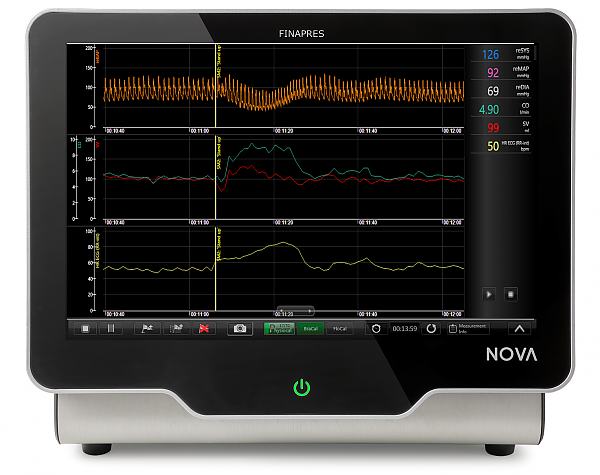|
Advanced Hemodynamics Application
Our Advanced Hemodynamics (HD) software application enables relevant hemodynamic parameters on the Finapres® Plus NOVA. This HD application gives more insight in various cardiovascular parameters, supporting health care professionals and researchers in studying and diagnosing their patients. It uses a statistical model of the human circulation to calculate the hemodynamic parameters from the finger arterial pressure waveform [1].
This algorithm computes the aortic flow waveform by simulating a non-linear three-element model of aortic input impedance [1]. The aortic impedance is modelled based on the age, length, weight and gender of the patient, while the systemic vascular resistance is predicted from the mean pressure and model mean flow. This so-called Modelflow® algorithm was developed in the ‘90s by Wesseling et al.[1] and is widely validated [2-5]. |
As an example of a potential application of the HD software, the image above shows the immediate blood pressure (reBAP), heart rate, CO and SV response during a stand test recorded with the Finapres® NOVA Plus. |
Features
- Non-invasive beat-to-beat hemodynamic parameters such as Cardiac Output (CO) and Stroke Volume (SV)
- Optimized for trending
- Absolute CO accuracy through calibration
|
Parameters
|
|
References
- Wesseling, K. H., et al. "Computation of aortic flow from pressure in humans using a nonlinear, three-element model." Journal of applied physiology 74.5 (1993): 2566-2573.
- Harms, Mark PM, et al. "Continuous stroke volume monitoring by modelling flow from non-invasive measurement of arterial pressure in humans under orthostatic stress." Clinical Science 97.3 (1999): 291-301.
- Jansen, J. R. C., et al. "A comparison of cardiac output derived from the arterial pressure wave against thermodilution in cardiac surgery patients." British journal of anaesthesia 87.2 (2001): 212-222.
- Leonetti, Pascal, et al. "Stroke volume monitored by modeling flow from finger arterial pressure waves mirrors blood volume withdrawn by phlebotomy." Clinical Autonomic Research 14.3 (2004): 176-181.
- Bogert, Lysander WJ, and Johannes J. van Lieshout. "Non‐invasive pulsatile arterial pressure and stroke volume changes from the human finger." Experimental physiology 90.4 (2005): 437-446.

